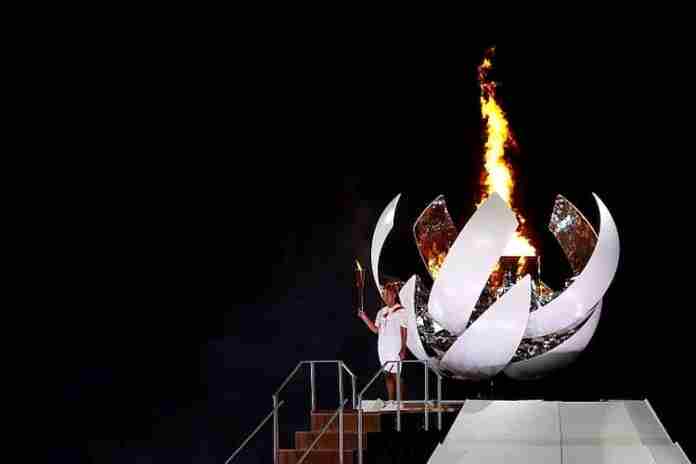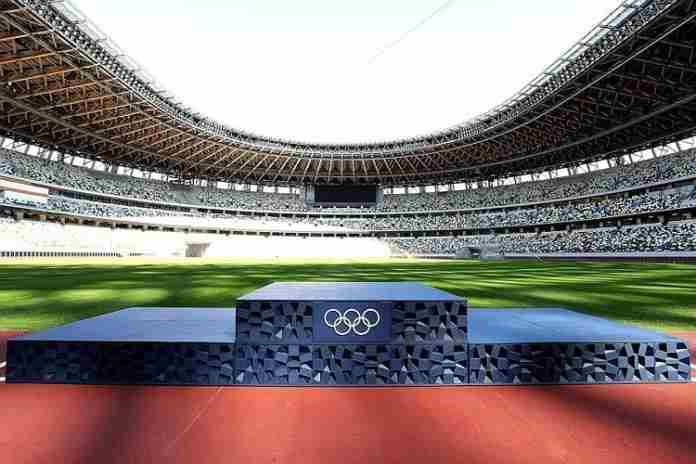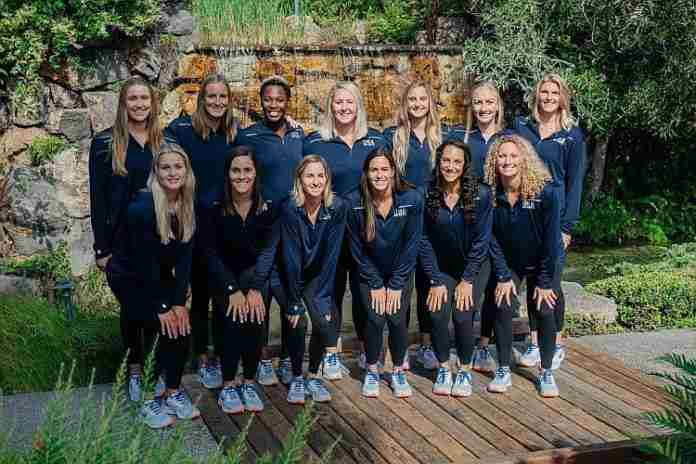Once again, the Olympic Games has started, and in the elegant, precise and dramatic style hoped for in Tokyo’s Olympic Stadium.
But the stadium was empty, save for about 950 dignitaries – including Emperor Naruhito – and perhaps 6,000 news media. But the show went on, impressively, crowned by a powerful, six-part arrival of the Olympic Torch, ending with tennis star Naomi Osaka lighting the cauldron.
The ceremony started right on time at 8 p.m. Tokyo time, in warm (82 degrees F) and humid (76%) conditions, with a stark focus on a single runner, opening to a fireworks display and a spectacular show of technology as the entire floor of the stadium was lit with a brilliant set of geometric projections.
An elegant stage set was brought on the field, with a stepped representation of Mt. Fuji in the middle, topped by the (closed for now) cauldron for the Olympic Flame. A dance program of great dignity and solemnity followed, but even the carefully-choreographed television coverage showed the rows of empty seats in a glittering, almost-new stadium.
This was followed by a moment of silence “to remember loved ones who are no longer with us,” an indirect reference to the Covid-19 pandemic, but also to those who have passed since the Games were postponed from 2020. This was followed by a first-ever segment in an Opening Ceremony commemorating the massacre of Israeli athletes and officials at the Munich Games in 1972; the field was blackened except for the Mt. Fuji stage, bathed in blue, with a white spotlight on the middle of the field; a moment of silence was observed.
A 14-minute cultural presentation followed, which included a “construction” project that “built” the Olympic Rings on the field and an energetic tap routine from Kazunori Kumagai, followed by a massive fireworks display.
The colorful parade of nations started 37 minutes into the ceremony and passed by much more quickly than in past Games, as all of the larger delegations were compressed by the restrictions on when athletes could come to Tokyo. Most of the delegations had two flagbearers – one man, one woman – as now allowed, and almost everyone had their phones out for selfies and videos, even in an empty stadium.
Some 5,700 were expected to march, so even with the program moving along smartly, it took an hour for 95 National Olympic Committees to come in.
As future hosts of the Games, the U.S. and France were at the end of the parade, followed by host Japan. The U.S. entered at 10:30 p.m., with flagbearers Sue Bird (basketball) and Eddy Alvarez (baseball) and a huge delegation, but which moved swiftly to their place on the field.
Japan entered at 10:33 p.m., closing the parade right on schedule, an impressive achievement on its own.
The newly-rewritten Olympic Oath was taken by Japanese athletes Ryota Yamagata (track & field) and Kasumi Ishikawa (table tennis), judges Asumi Tsuzaki (water polo) and Masato Kato (surfing) and coaches Kosei Inoue (judo) and Reika Utsugi (softball).
This was followed by a “Unity in Diversity” program that began with the movement of 45 colored boxes on the field that eventually formed the Tokyo 2020 logo. That symbol was picked up by an amazing formation of 1,824 drones which moved in a sequence that morphed into a blue-and-white representation of the earth. That was awesome.
Brief speeches were given by Tokyo 2020 chief Seiko Hashimoto and International Olympic Committee President Thomas Bach (GER). Bach praised the efforts of the Japanese people, the volunteers and many others who made the Games possible, and the difficult path of the athletes during the pandemic:
“You did not even know whether this competition would take place at all. You struggled. You persevered. You never gave up. And today, you are making your Olympic dream come true.”
And he returned to his constant theme of the Olympic Movement at the service of the world through sport, a philosophy which has radically changed the way the Olympic world works:
“Our Olympic community learned that we can address the many big challenges of our times only if we stand together. The lesson we learned is: We need more solidarity. More solidarity within societies and more solidarity among societies.
“Solidarity means much more than just respect or non-discrimination. Solidarity means helping. Sharing. Caring. This is what we are do in our Olympic community. We are standing in solidarity to make the Olympic Games happen and to enable all of you, dear athletes, from all National Olympic Committees – whether big or small, whether rich or poor, and from all Olympic sports – to take part of the Olympic Games.”
Emperor Naruhito then opened the Games in Japanese, followed by the entrance and raising of the Olympic flag in three stages: first by a cadre of six athletes – one from each continent and the Refugee Olympic Team – then a group of eight “essential workers” from Japan saluting their role in working against the pandemic and finally a seven-member group from the Japanese Self-Defense Force.
A release of paper doves – live doves are no longer used – was followed by an inventive reflection on the Tokyo Games of 1964. The now-familiar sports pictograms were invented for that Games and the 50 pictograms for today’s Games was saluted in a clever sketch, primarily with three mimes working together to create human versions of each one.
A three-minute video showcasing the Olympic venues and Tokyo the city, leading to a live Kabuki performance on the stage was the prelude to one of the most complex torch-lighting ceremonies ever staged.
The Olympic Torch appeared in the stadium at 11:38 p.m. Tokyo time and proceeded through six stages:
● 1: Dr. Tadahiro Nomura (a judoka) and three-time wrestling gold medalist Saori Yoshida, bringing the torch into the stadium;
● 2: Three Japanese baseball legends: Shigeo Nagashima, a slow but steady Sadaharu Oh, now 81, Japan’s baseball icon, and former Yomiuri Giants and Yankees star Hideki Matsui;
● 3: Dr. Hiuroki Ohashi and Junko Kitagawa, a nurse, representing the medical corps at the center of treating the pandemic;
● 4: Paralympian Wakako Tsuchida, who moved the torch on her wheelchair;
● 5: A group of six elementary school and junior high students representing regions of Japan which had been devastated by earthquake and the Fukushima nuclear disaster, who handed off to
● 6: Tennis star Osaka, who ascended “Mt. Fuji,” with the top opening to reveal a dazzling interior crystalline cauldron, and lit the Olympic Flame.
This was a moving ceremony, beautifully produced, but sadly without the emotion that a live audience brings. But it opened what will be a memorable Games, one that many thought would never happen. But here it is; the party has started.
¶
For those who didn’t get up early, NBC will re-air the ceremony this evening (check your listings for air time), so you can check out the amazing technical effects and the very-well-performed cultural and ceremonial elements, especially since you now know what to look for! That drone sequence is worth seeing again and again. Wow.
You can receive our exclusive TSX Report by e-mail by clicking here. You can also refer a friend by clicking here, and can donate here to keep this site going.
For our 649-event International Sports Calendar for 2021 and beyond, by date and by sport, click here!

























